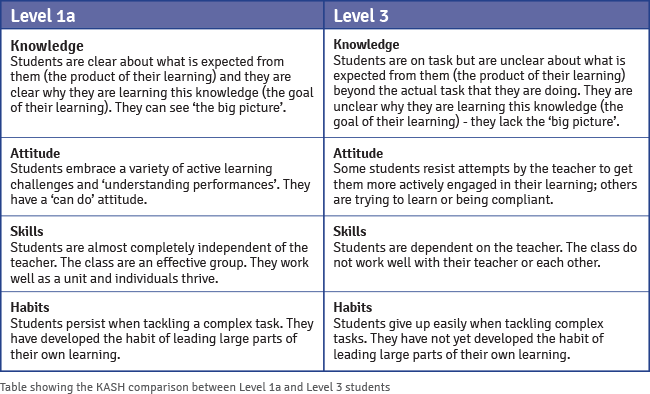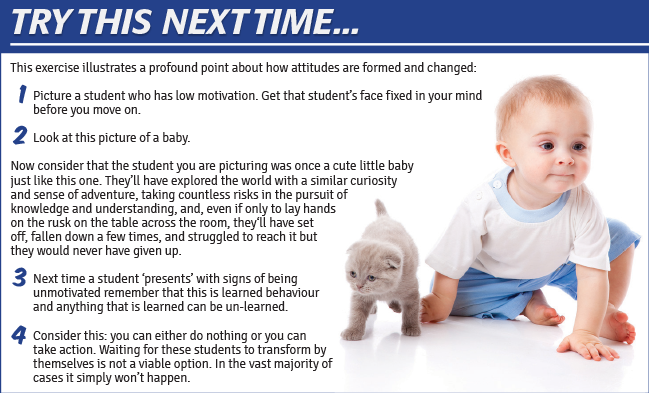In our experience the main reasons for students’ lack of engagement fall into the four areas of KASH: Knowledge, Attitudes, Skills, and Habits.
Students lack the ‘right’ knowledge
In order to make progress students need to know their current level of performance. They therefore require accurate knowledge of their level of performance. Highly engaged students also know where they want to go with their learning – they know why they need to persist, to take advice, to work hard. This is because they are working towards a personal goal.
We find it interesting that of the thousands of students we have taught it is not necessarily those with the most problematic lives that are the most disengaged. It’s true that some students have had traumatic experiences in their young lives, but this doesn’t have a direct causal link to the student’s ability to become highly engaged. Actually it’s the knowledge of how to put those issues behind them and stay in the moment that determines their ability to focus.
Students lack the ‘right’ attitudes
Some students can’t or won’t come on a learning journey with their teacher. We do not mean specific learning difficulties or even physiological factors (e.g. poor sleep patterns or a poor diet). What we’re talking about is learned behaviour in relation to their beliefs about themselves and their attitude to the way, in their view, the world works.
One such attitude that can develop is learned helplessness. Learned helplessness is a term first coined by psychologist Martin Seligman and it refers to a set of pessimistic thoughts that the person holds to be true. These thoughts often harden into limiting beliefs, especially in relation to ‘trying’. Students with learned helplessness believe that they will fail and so see no merit in persisting or taking chances. This is where the ‘What’s the point?’ attitude can develop.
Students lack the ‘right’ skills
For a class to be regularly working at outstanding, it’s essential they have the right skills. They require individual skills, such as expressing themselves clearly, listening actively, reflecting on their learning and understanding what they have to do to improve. They also require the skills of working with others as learning takes place within a social context.
Students lack the ‘right’ habits
A habit is best explained as having the ability to do a task without any conscious thought; it becomes routine or as we call it a ‘norm’.
We know that if we reflect on ourselves for a few moments we have a mix of both good and bad habits. When it comes to how our students behave in our classrooms we can also appreciate this mix of good and bad learning habits.
We think that it is crucial to ‘start with the end in mind’. We have taken this directly from Stephen Covey’s influential book The 7 Habits of Highly Effective People (1989). It seems to us that teachers who regularly get judged as ‘outstanding’ have got into the habit of starting with the end in mind.
Because they are clear about what norms they are looking for they spend time training their students in the underpinning knowledge, attitudes, and skills required for them, if necessary, to change their habits.
The journey from Level 3 to Level 1
If you want to help your students become more motivated, rather than just accepting them as they are, you might be curious to read how a teacher can move his or her class from a low to a high level of engagement in just a few short weeks.

The strategies, above, require that you train your students to develop the skills and attitudes that will help them thrive at engagement Level 1a – a level high of challenge and independence, where problem solving and persistence are essential characteristics of getting into flow.
In particular, we need to explore strategies that support your students to:
- Cope with being stuck
- Do their best
- Work as part of a group
Training students to cope with being stuck
One area where teachers have really developed their students’ motivational strengths is training them to welcome and work through ‘being stuck’. If students are to make progress and achieve their learning goals it’s essential that they build capacity to overcome the hurdles in their way.
Being stuck can feel like a disaster or a sign of failure on their part. In extreme cases some students will throw down their pen and simply withdraw from the challenge. The fact is that being stuck is a necessary and normal part of most learning experiences.
We just have to work through it. Challenge and stuckness are essential elements for getting into flow. It’s therefore important for students to have a tool kit to get themselves unstuck.
We hope you find these range of techniques, that outstanding teachers frequently use to help their students deal with being stuck or confused, useful. You can find more of them in the book ‘Engaging Learners’ and on our Outstanding Teaching courses with Osiris Educational.
Stuck Board
Primary teacher Clare Gore has become a big fan of using stuck boards in her classroom.
Clare and other teachers like her train their students to use their stuck boards to develop new routines when they get stuck. The boards challenge them to use a range of strategies before asking for help and encourage the learners not to give up. The statement at the top of the board is important too. ‘We’re great learners’ is both an affirmation for the students and shows that their teacher believes in them.
Wonderwall
Humanities teacher John Brown has created a great routine for getting his students to share questions. He’s created a space in his classroom which he calls the Wonderwall. Here students can place questions on sticky notes throughout the lesson. He trains his students to share these questions without any fuss. When students are tackling their work John can look at the Wonderwall and then speak to individuals or groups to help them with their questions.
3B4ME
This routine is great for getting students to work longer on activities before they give up or ask their teacher for help. Stage 1 encourages students to think hard about ways they have tackled similar problems before and the successful strategies they used. Stage 2 encourages them to use all the available resources such as their books or the help desk. Stage 3 means they can ask a friend or other students. Only after these three stages have been tried can the students ask their teacher for support. SR



